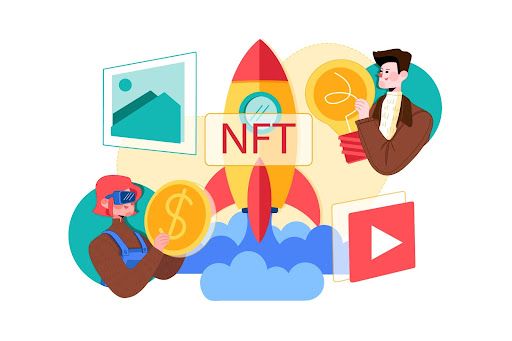How to Invest in NFTs
10/11/2022
A Simple Guide to Investing in NFTs
Web3 is rife with opportunities unlike the human race has ever seen before. The uprise of blockchain technology has created an entirely new landscape for investment through cryptocurrency and now more recently, the non-fungible token (NFT).
Since their explosion in 2021, NFTs have taken the investment world by storm. It seems everybody is now discussing what’s sitting in their digital wallet and what worthwhile investment they made from their own NFT sales.
So, I don’t blame you if you’re now desperately wondering how you too can start buying NFTs and join this growing movement, particularly if you’re looking for an easy way to expand your investment portfolio.
Some consider investing in NFTs to be high risk investment, but the good news is, investing in NFTs can be fairly easy to get into and risk can be somewhat reduced if you have some know-how. With this simple guide you can begin kickstarting your NFT investing journey in no time.
What are NFTs?
Okay, let us start by unpacking what a non-fungible token even is. Essentially, NFTs are the new digital future of collectibles. Any real-world asset such as art, music, and games can now be digitally represented through this token-based system.
Like cryptocurrencies, they are based on blockchain technology. The key difference between these non-fungible assets and their fungible counterparts is that they cannot be interchanged or replaced. They have a unique digital signature referred to as a smart contract that records the history of transactions.
At the crux of it, NFTs are tradable digital receipts of purchase stored on the blockchain.
How can this digital asset work in my favour?
Now that you have a basic understanding of what these tokens are, you might be wondering how NFTs work as investable assets. As mentioned, they are non-fungible. This is what really sets these tokens apart as an asset because it means any one NFT is unique, and its value cannot be interchanged with something similar. Contrasting to this is the dollar bill, a common fungible asset. If I gave you my dollar bill and you gave me yours, we still have the same item of the same value.
what do the people want?
Like other physical types of art, NFTs hold a value that is primarily set by buyer demand. In fact, most NFTs do not have a fixed price, rather they are worth what someone is willing to pay for them. The rarer an NFT is, the more value potential it has. It must be said that the subjective nature of the NFT marketplace does make investing in NFTs a more high-risk investment.
That being said, the market shows a significant amount of potential for investors as the start of this year saw many NFTs skyrocket in value. Much like physical collectibles, they have also shown to be reliable in terms of their value appreciation.
Financial freedom through NFTs
When you think about ways to invest in NFTs, it shouldn’t look like buying NFT stocks. Rather, you are going to leverage a growing market and create NFTs to generate income. Through NFTs, you can create art and turn it into a digitalised format.
Royalty fees
This same underlying technology allows you as the creator to set royalty fees for whenever your digital art is exchanged on the secondary market. This is an easy way to earn a passive income from your product even after your original sale. Once you set your predetermined percentages, smart contracts will take over in governing the entire process. You can sit back and relax, whilst royalties and tracking of payments is dealt with by self-executing computer programs! Cool right?
Dynamic Vs Static
Not all NFTs are the same, and we’re not just referring to the uniqueness mentioned earlier. There are two forms of an NFT digital asset, the dynamic and static form. Dynamic NFTs can change their properties over the course of time.
For instance, digital artists are able to make modifications to their artwork after creating it. On the other hand, static assets are immutable and permanent. This is something to keep in mind when you’re looking to invest in NFTs or create your own digital assets.
NFT marketplaces, the marketplaces of the future
So where does one buy and sell NFTs? Well, as mentioned, non-fungible tokens exist on blockchains. More specifically, the majority of tokens call the Ethereum cryptocurrency’s blockchain home. Any time an NFT exchange occurs, the blockchain will act as a distributed public ledger that records the transaction and gives the buyer a unique access code.
NFT marketplaces, where tokens can be bought and sold, are located within the blockchain. Whilst most NFT marketplaces reside within the Ethereum blockchain, there are many blockchains which coincides to there being many marketplaces. Not only this, but with NFT demand continuing to surge, cryptocurrency exchange firms are now launching their own NFT marketplaces.
The world of art is changing forever
The community that has perhaps been most influenced by the NFT is the art world. Notably, the most popular use of NFTs is to buy and sell digital artwork. Many artists have praised NFT technology for creating a more democratic model for selling art, as it allows digital artists to create original art that cannot easily be replicated.
Moreover, what sets them apart from your ordinary art auction is the valuable data stored within tokens. This data makes verifying and validating ownership very straightforward, which helps to greatly minimise fraud, and therefore, reduce high risk investments.
How to invest in NFTs?
Alright, we know, you want a clear answer to a simple question… How to invest in NFTs?
Step 1: Set up your digital wallet
In order to start investing, you will need to set up a crypto wallet and buy some cryptocurrency. To purchase cryptocurrency, you can use fiat money. As stated earlier, most NFTs are Ethereum based. This means finding a cryptocurrency that is compatible with the Ethereum blockchain, such as Ether. You can buy Ether on any of the top crypto exchanges such as Coinbase or Gemini. Having a digital wallet is essential because once you’ve purchased your NFT, it will be the storage place for the keys to your NFT.
carry a crypto wallet?
Your new digital wallet can either be software based or a hardware device. Software wallets can simply be downloaded and are more convenient. However, hardware wallets, which one can physically keep are more secure.
Step 2: Pick an NFT marketplace
Your digital wallet, once set up, will link with marketplace platforms. As you know there is many an NFT marketplace, so spend some time deciding which one you like. Currently, one of the largest NFT marketplace is OpenSea which prides itself on its variety of rare digital items and collectibles. Other reputable NFT marketplaces include Rarible, Axie, SuperRare, Nifty Gateway, Mintable, and Foundation. Once you’ve selected one, follow the steps to link your wallet.
Step 3: Buy NFTs
With your digital wallet connected to your marketplace of choice, you’re ready to buy NFTs. You can also generate NFTs of your own, but that’s another article on how to make new NFTs. When purchasing NFTs, you will notice that they vary in many ways. Many NFTs come in collections whilst others are individual pieces. Some tokens can cost only a few dollars whilst others come in at over a million.
some fees
However, regardless of what the price tag says, you’ll be required to also pay what’s called transaction fees. Ethereum in particular has been criticised for having very high Ethereum gas fees. In fact, some NFT buyers have paid more in gas fees than they did for the NFT itself! Another thing to note is that whilst some NFTs have a buy now option, you’ll probably have to bid for the specific NFT you want via a virtual auction within the marketplace.
As with any creative industry, one must be cautious about ‘counterfeit’ NFTs. When you go to buy NFT, ensure you’re scrutinizing the person you are buying from, as fraudulent NFTs are frequently sold by impersonators of creators and celebrities. Moreover, be careful of NFTs that have an associated image or other digital form, as that connected NFT data may be stored in a separate blockchain network, thus, blurring the lines of “ownership.”
Step 4: Sell NFTs
Now comes the fun part where you can really start investing. So, you’ve made your purchase and now your NFT is sitting in your crypto wallet ready for you to sell. All that is required for selling NFTs is to simply list your NFT for sale or for auction and watch the bidding wars begin.
Much like when you make an NFT purchase, selling your tokens also comes with fees. Once the deed is done, the blockchain will handle everything between you and the buyer involving the transfer of the digital asset, the ownership of it, and the crypto funds.
When you do invest in NFTs, there are both short term and long-term strategies. If you’re wanting to participate in short term investing, it’ll be a bit like day trading stocks, and you’ll have to keep a keen eye on what the market is doing.
Most short-term strategies involve trying to buy NFTs at a low price and resell them for a quick profit. In terms of long-term investing, you’ll want to pick an NFT that you believe will appreciate in value.
Good luck out there!
Now you know how to invest in NFTs. When it comes to investing in NFTs, pros and cons need to be weighed up like any financial decision. Good luck out there!





